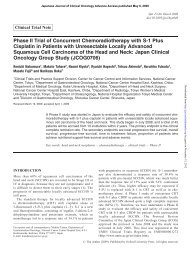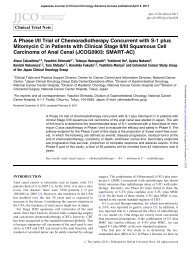A Case of Estrogen Receptor Positive Secretory Carcinoma in a 9 ...
A Case of Estrogen Receptor Positive Secretory Carcinoma in a 9 ...
A Case of Estrogen Receptor Positive Secretory Carcinoma in a 9 ...
Create successful ePaper yourself
Turn your PDF publications into a flip-book with our unique Google optimized e-Paper software.
Page 2 <strong>of</strong> 4 <strong>Secretory</strong> carc<strong>in</strong>oma <strong>in</strong> a 9-year-old girl<br />
Figure 1. (a) Tumor section show<strong>in</strong>g neoplastic cells with abundant clear <strong>in</strong>tracytoplasmic material those present <strong>in</strong> glands and nests. (b)<br />
Immunohistochemically sta<strong>in</strong>ed tumor section. More than 10% <strong>of</strong> the tumor cells show expression <strong>of</strong> estrogen receptor <strong>in</strong> nuclei (SP1, Predilute: Roche).<br />
had an ETV6–NRK3 fusion gene with weak basal-like differentiation,<br />
who underwent mastectomy with sent<strong>in</strong>el node<br />
biopsy. In children with cl<strong>in</strong>ically node-negative breast<br />
cancer, we believe that f<strong>in</strong>e-needle aspiration cytology<br />
(FNAC) is needed, even if the lesion appears to be benign,<br />
and that to avoid life-long complications, sent<strong>in</strong>el node<br />
biopsy is an appropriate alternative to axillary dissection.<br />
CASE REPORT<br />
The patient was a 9-year-old premenarcheal pediatric female,<br />
whose pr<strong>in</strong>cipal compla<strong>in</strong>t was a well-circumscribed palpable<br />
right breast mass. The lump had been noticed by the patient 2<br />
years previously and its size had been stable. There was no<br />
prior or family history <strong>of</strong> malignancies. The patient’s development<br />
was normal for her age. Physical exam<strong>in</strong>ation showed<br />
a well-delimited, elastic-firm and movable tumor just beneath<br />
the nipple and areolar complex. Nipple discharge or retraction<br />
was not observed. The patient did not feel spontaneous pa<strong>in</strong><br />
but felt tenderness at the lesion. The size <strong>of</strong> the tumor was<br />
1.5 1.3 cm and it was not fixed to the muscle. The axillary<br />
or supraclavicular lymph node was not palpable. The left<br />
breast was unremarkable. Ultrasonography revealed a subareolar<br />
oval-shaped tumor show<strong>in</strong>g homogeneous echogenicity<br />
with clear marg<strong>in</strong>s (15.9 13.9 mm <strong>in</strong> size). The ultrasonographic<br />
f<strong>in</strong>d<strong>in</strong>gs related to the tumor were def<strong>in</strong>ed as<br />
Category 3b (8). The lactiferous duct or mammary gland was<br />
not observed. Mammography depicted the tumor as a partially<br />
lobulated mass. The marg<strong>in</strong> <strong>of</strong> the mass was almost clear.<br />
Breast computed tomographic (CT) scans showed a homogeneously<br />
enhanced lesion (17 16 mm <strong>in</strong> size) with a clear<br />
marg<strong>in</strong>. Regional lymph nodes or distant metastases were not<br />
detected by whole-body CT scans. The aspiration specimen<br />
taken from the lesion showed atypical cells with prom<strong>in</strong>ent<br />
nucleoli and abundant <strong>in</strong>tracellular secretory material, suggest<strong>in</strong>g<br />
that the tumor was possibly an SC. A core needle<br />
biopsy (CNB) specimen revealed that the neoplastic cells<br />
formed glands and nests with abundant clear <strong>in</strong>tracytoplasmic<br />
material, which was positive for the periodic acid Schiff<br />
(PAS) reaction. The background <strong>of</strong> the lesion was associated<br />
with prom<strong>in</strong>ent hyal<strong>in</strong>ized fibrous tissue. Another characteristic<br />
feature was the presence <strong>of</strong> extracellular Alcian bluepositive<br />
secretory mucosubstance. The patient was subsequently<br />
given a def<strong>in</strong>itive diagnosis <strong>of</strong> SC (T1N0M0 Stage I).<br />
Us<strong>in</strong>g mammography, we confirmed that the extent <strong>of</strong> the<br />
patient’s mammary gland was comparable with that <strong>of</strong> adults.<br />
She underwent total mastectomy with sent<strong>in</strong>el lymph node<br />
biopsy by means <strong>of</strong> a double-mapp<strong>in</strong>g method. Total mastectomy<br />
was performed <strong>in</strong> an identical manner to that for adults.<br />
We removed two hot nodes as sent<strong>in</strong>el nodes and two swollen<br />
lymph nodes which were adjacent to the sent<strong>in</strong>el nodes.<br />
The <strong>in</strong>itial diagnosis <strong>of</strong> the tumor us<strong>in</strong>g FNAC and CNB<br />
wasconfirmedonpermanenthistopathological exam<strong>in</strong>ation<br />
(Fig. 1a). The lesion was surrounded by a thick wall and its<br />
marg<strong>in</strong> status was negative. Metastases were not observed <strong>in</strong><br />
the sent<strong>in</strong>el lymph nodes and two adjacent nodes. The<br />
estrogen receptor (ER) was weakly positive (Fig. 1b) and the<br />
progesterone receptor was negative. Human epidermal<br />
growth factor receptor 2 (HER-2) expression was also negative.<br />
Immunohistochemistry revealed weak basal differentiation<br />
[CK5/6(þ), viment<strong>in</strong>(þ) and epidermal growth factor<br />
receptor (EGFR) (þ)] (Fig. 2a–c). The antibodies that we<br />
used were as follows: anti-ER (SP1, Predilute: Roche, Basal,<br />
Switzerland); anti-PgR (1E2, Predilute: Roche); anti-Her2<br />
(Rabbit polyclonal 1:300: Dako, Carp<strong>in</strong>teria, CA, USA);<br />
anti-CK5/6 (D5/16B4, 1:100: Dako); anti-viment<strong>in</strong> (V9,<br />
1:100: Dako); anti-EGFR (EGFR25, 1:50: Leica<br />
Microsystems, Bannockburn, IL, USA).<br />
In order to confirm the diagnosis, we needed to detect the<br />
ETV6 (exon 5) and NTRK3 (exon 13) fusion gene<br />
t(12;15)(p13;q25) <strong>of</strong> 511 bp us<strong>in</strong>g the reverse transcription–<br />
polymerase cha<strong>in</strong> reaction (RT–PCR) method. This gene is<br />
specific to SC. We extracted total RNA from snap-frozen<br />
tissue. PCR was carried out to amplify the ETV–NTRK3<br />
fusion gene us<strong>in</strong>g 5 0 -TCCTCCGAGTCCCACCCGAAG-3 0 as<br />
a forward primer and 5 0 -CATCGCCGCACACTCCATA<br />
GAA-3 0 as a reverse primer. We detected the PCR products<br />
Downloaded from<br />
http://jjco.oxfordjournals.org/ by guest on August 4, 2013







